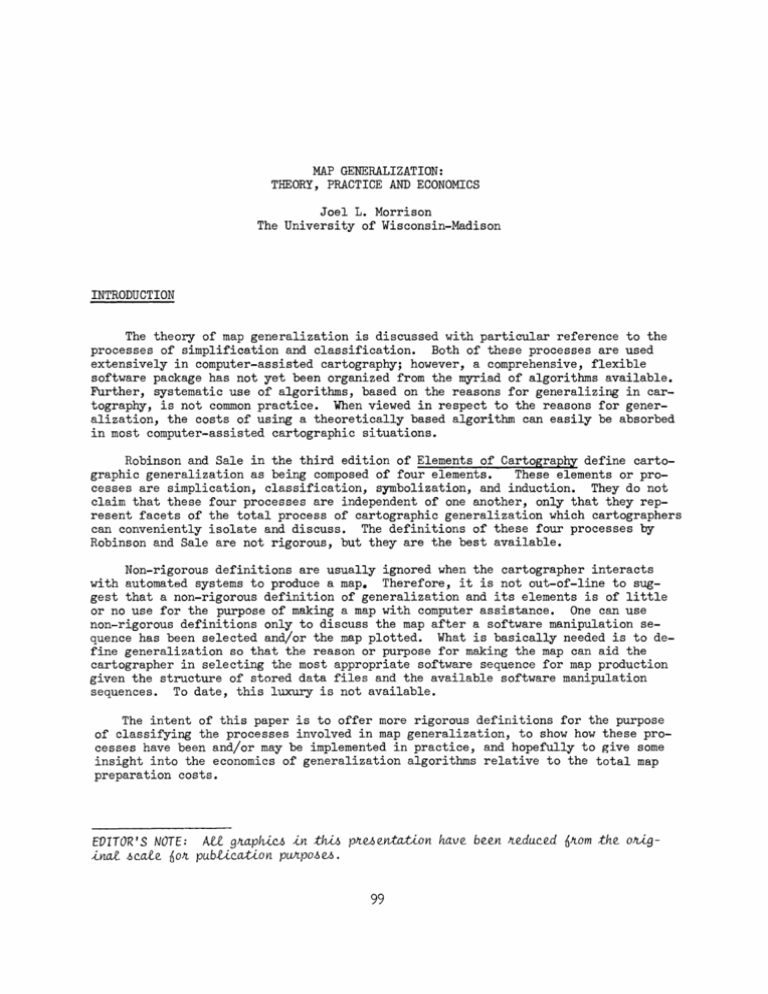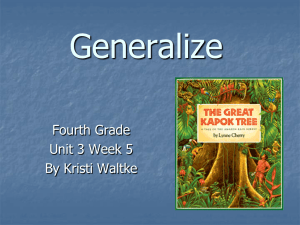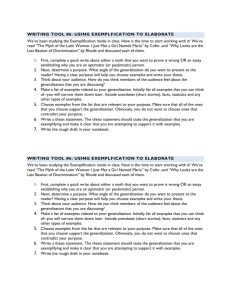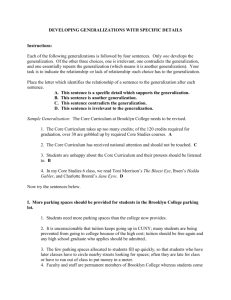Map Generalization: Theory, Practice and
advertisement

MAP GENERALIZATION: THEORY, PRACTICE AND ECONOMICS Joel L. Morrison The University of Wisconsin-Madison INTRODUCTION The theory of map generalization is discussed with particular reference to the processes of simplification and classification. Both of these processes are used extensively in computer-assisted cartography; however, a comprehensive, flexible software package has not yet been organized from the myriad of algorithms available. Further, systematic use of algorithms, based on the reasons for generalizing in car tography, is not common practice. ¥hen viewed in respect to the reasons for gener alization, the costs of using a theoretically based algorithm can easily be absorbed in most computer-assisted cartographic situations. Robinson and Sale in the third edition of Elements of Cartography define carto These elements or pro graphic generalization as being composed of four elements. cesses are simplication, classification, symbolization, and induction. They do not claim that these four processes are independent of one another, only that they rep resent facets of the total process of cartographic generalization which cartographers can conveniently isolate and discuss. The definitions of these four processes byRobinson and Sale are not rigorous, but they are the best available. Non-rigorous definitions are usually ignored when the cartographer interacts with automated systems to produce a map. Therefore, it is not out-of-line to sug gest that a non-rigorous definition of generalization and its elements is of little or no use for the purpose of making a map with computer assistance. One can use non-rigorous definitions only to discuss the map after a software manipulation se quence has been selected and/or the map plotted. What is basically needed is to de fine generalization so that the reason or purpose for making the map can aid the cartographer in selecting the most appropriate software sequence for map production given the structure of stored data files and the available software manipulation sequences. To date, this luxury is not available. The intent of this paper is to offer more rigorous definitions for the purpose of classifying the processes involved in map generalization, to show how these pro cesses have been and/or may be implemented in practice, and hopefully to give some insight into the economics of generalization algorithms relative to the total map preparation costs. have, been reduced EPITOR'S NOTE: Mi giaphicA A c.at& £01 publication 99 the. THEORY It is possible to redefine and categorize the four processes of generalization mentioned above as transformations possessing or not possessing certain properties. The transformational properties considered are two: the property of being one-toone and the property of onto. A function f: A + B is said to be one-to-one if dis tinct elements in A have distinct images, (i.e., if f(a) = f (a 1 ) => a = a'). A function f: A+B is said to be onto if every beB is the image of some aeA, (i.e., if beB = >aeA for which f(a) = b). 2/ The property of one-to-one is the easier to understand. If there exists a data file A and a derivative data file B resulting from a transformation of file A, so long as each single entry selected from file A results in a single entry in file B, the property of one-to-one is preserved. The onto property is a little harder to illustrate. It requires that every entry in file B have a referent entry in file A. In other words, file B has no element that has no referent in file A. The possession or lack thereof of these two properties gives four possible cate gories of transformations: l) transformations that are both one-to-one and onto (bijective), 2) transformations that are neither one-to-one nor onto, 3) transfor mations that are one-to-one and not onto, and finally h) transformations that are onto but not one-to-one. If one examines closely how a cartographer generalizes, it appears reasonable to refer to a transformation that is one-to-one and onto as approximating the pro cess of simplification, a transformation that possesses neither property as induc tion, a transformation that is one-to-one but not onto as symbolization and finally a transformation that is onto but not one-to-one approximates classification. If cartographers then use these transformation properties to refer to the four pro cesses of generalization, any algorithm can be classified as to .which generaliza tion process or combination of processes it approximates. Thereafter discussion can follow based on the knowledge that everyone involved understands what each other means by a simplification process or a classification process. To use these more rigorous definitions of the processes of generalization can help the cartographer. But before this can be illustrated, the term "map" must also be defined. Simply stated, a map is a communication channel. Its primary function is to serve as a vehicle to communicate information from one cognitive realm to another cognitive realm. To start the mapping process, an idea about what the car tographer wishes to communicate initiates a selection from his cognitive realm of information to be communicated. (See Figure 1.)This initial selection is both one-to-one and onto and is not part of map generalization. Only after this selec tion process can map generalization take place, and furthermore, the processes of map generalization can only take place under certain additional constraints. Ideally all of the following constraints are present: purpose of map, map for mat, scale, intended audience, data quality, and graphic limitations. Practically, of course, there is an economic constraint; and in fact, all of the above con straints are usually based in economic terms. After the selection process, generalization of the selected information can take place to form the cartographer's conception of the map (illustrated as set A" in Figure l). The processes of simplification and classification may be performed sequentially several times and in any order until the cartographer has arrived at a conception of the map, A" = C"UD. Once the cartographer has a conception of the 100 map, symbols can be assigned and thus the third generalization process, symbolization, becomes operative. 1. Tke. mapping The cartographer may reiterate back to more simplification and/or classifica tion transformations if a given symbolism appears inappropriate, but in automated cartography such reiteration may become costly. In fact, the automated case of map production is only efficient where the cartographer has so specified the conception of the map that each generalization process need be performed only once. The final process of inductive generalization accompanies symbolization and the cartographer has little or no control over it. But if the three processes of simplification, classification and symbolization are done well, induction will probably not hinder the communicative effectiveness of the map. Rather inductive generalization usually enhances a map's effectiveness. According to this line of reasoning then, in theory, map generalization is a series of processes defined by the properties of their transformations applied to a selected set of information with the explicit purpose of efficiently conveying that information via a communication channel called a map to a map reader or a map-read ing audience. How is this instituted into cartographic practice and, more specific ally, into computer-assisted cartographic practice? PRACTICE In computer-assisted cartography, two types of computer-readable data storage currently predominate: 1) data stored as strings of coordinates (mostly the result of digitizing), and 2) data stored as picture elements (remotely sensed or scanned) While all four generalization processes can operate on both types of stored data, this paper will concentrate solely on the processes of simplification and classifi cation while ignoring symbolization and induction. 101 SIMPLIFICATION Two cases can be identified in the simplification of data stored as strings of coordinates: 1) point simplification and 2) feature simplification. Point sim plification refers to the simplification of a string of coordinate points defining a line or the outline of an area. Such simplification takes place by eliminating all points but a chosen few that are deemed more important for phenomonological character retention. The feature case of simplification occurs when many small items of the same class are present in an area. Certain of the items are retained while others are omitted. The essential character is retained while detail is elim inated. In addition to these two cases of simplification, the simplification of data stored as picture elements can consist of smoothing techniques including sur face fitting, and/or enhancement procedures. Phenomena exist in reality as points, lines, areas or volume. It has been shown that by rigorous definition the. cartographer conceives of these for mapping purposes as really only three categories: point, line and area/volume, jj The car tographer must conceive of all data as existing for mapping purposes in one of these three categories. Theoretically, when discussing data stored as strings of coordi nates, each of these three categories can occur in each of the two cases, point and feature simplification; however, if the features themselves are points, there need be no difference in the simplification algorithm between the two cases. Figures 2 and 3 illustrate the point case for line data and the feature case for area/volume data respectively. In Figure 2, the map of Portugal illustrates 2. tin&> ^oin selected po<in&> 102 that simplification of lines results from the one-to-one transformation of selected points onto a new map. The points denoted on both sides of Figure 2 are exactly the same. These selected and transferred points from the left map are connected by straight line segments and are shown on the right map. Simplification by feature elimination is illustrated in Figure 3> which shows forest cover areas of Sheboygan County in Wisconsin. In feature elimination sim plification, either a feature is shown in its entirety or it is omitted. In Figure 3, the smaller areas present on the map on the left are eliminated on the map on the righti Obviously it is possible to combine point and feature elimination sim plification by eliminating features and by point simplifying the outlines of the uneliminated features. " ^ ''.1'ja ^5>*-tf *;?'-/* .,> ' '* ' : /^IAS»:XV-V ^^Ste;: ^ fit ^ ^-i/ ^' j. SimpLLfccjuti-on by fincutusie. For data stored as picture elements, simplification using a smoothing operator is illustrated in Figure k. The picture elements are evaluated one at a time and retained as is or modified; thus the transformation retains its properties of oneto-one and onto. Simplification can be applied along either of two dimensions. Either a reduc tion in the scale dimension (see Figures 7 and 8), i.e., reduction from an original scale to a smaller scale representation, or a simplification along some constant scale dimension (see Figures 5 and 6), i.e., a detailed representation versus a sim plified representation at the same scale. Figures 2, 3> and h are all illustrations of this latter type. Along either of these two dimensions, the process of simpli fication can be applied to each data category in both point and feature elimination cases and/or using smoothing operators. Usually generalization in practice calls for an application of the simplification process primarily along the dimension of scale reduction and secondarily along the dimension of constant scale. It also usu ally involves, for stored data strings, both the simplification of points and fea ture elimination. 103 2222222?2222 3T!Ft222222222222 33lf?2222222Z222? 2f999<Ul1111111111 1111 ifeji! 3tfe 22 2222222 C99Q9 9 9911111111111 11 111JM7 333Q?-22?222? 9El?l9 t=E337l9_99qi111 11111JL9E 333E22272222 J 7 33fc9fe3 2 7 3?yil 111111111 I 37i2?22222222 '32022222222 333 ! 33jjp22<:22222 3 3 3 3?373 7 L2227272722 3333 3 7 ;7 3 33 7 33773337 333 7 TJ ^^^^3? 7 7 7 7, 7 9 C Q g c; g 9 9 9 o < '222272222 222222222222 222222222 2 22222222 '22272222 ? 733 3 7 aTT-c 9^999 ?7TX^T 77^999 !222222?2? : 3333F999E2?2 ! 7 333 7 33? 7 3?3 1777.7,77777^777^1 L2222272222 ~~~* J~J ^ 22272222 222222222 if 3 7 3 7 3B.^ g V?9 <3 9 9 9 1Z2??;2E.7- 7 3 7 3 7 332 7I Z2Z2227Z22222Z72222 Z2222222222? ___ 53331733 I 7 T 7f5?9l? •"373 7 373 7 3F9ffi 3 7lt2?2227222? ? 3 3 311113 773 7-3 7 3 7 3 7 733333373P2227272727 2 2 2 2FPT? 2 22222222222 ?3i3'333 7>2222222?2222 __ IT 111TTTTT 1| 22Z222Z?222? 7222222222222 2 2222222P2222 Z 2 2 ? 2 2 Z 7 27 2 ? 222222 22222 2 Z2?222p3>3 7 33 7 33. 7222?222?2222 5 33J2CI? 2 Z72T3 7 3 3 3 7 3tJ33 2222222222222 133^27-222227273 ^ 222222Z?222Z 5?3!3 7 333 7 3 7 2 7 33T 222222222222 3 3 777 ?33333T?3 333 22222?222?2?22 ___ 3 3 3 7 3? 733 3333^2222 222222 P33 77^3333 7 3 7 3 7 27323 7 3 3E722272222 2222 3 2 3 7 3 3 703 7 37373 7 73333 ? 3 7 3 7*! S 2V; 4? 2 7 2 7 : 2 3 3 3 7 3 3 3 7 313 7 3 7 3 7 3PET- 3 3 3 7 3g^g 3 TT7!? 7 2^ !222 ?22222222?2222222?22223327 _ 22222222222222272 Z2Z22 2 ? 2P 3 3 1 L999I11 11 1111 11111 1B3 3333 33C222 2222 I L9 99JL111 1111111 11T\33333 3^222 2222 369999111 1111111111111 1I333332 22 2 2 11 11111111 1 11111111 33333E2Z2 1 1 1 1 1 1 1 11^3362222 111C33E222 2 3333333333333333333333333333322222 3333333333333333333333333333222222 3333333733333333333 333333333333373 33333337333 333333373333373 3333333 7 333: 333733373333333' 33333333333333371 3337.333 7 333 3333333 7 33373333333 33733333733: 2222222 2222222 72222222 333333 ?222222 33333 22222222222227222222222222222 2333332222222722222??22222272222222 333 3J22 2 7?22?2?2? 2 22TO 22222272222222 3333J22222222222? 2EP 7 5|jg f^E ^2222222 333 7t2 272222 2?P 7 3 73 33333 33fe 72222272 33333^2722222p3 7 333 7 333333^22222222 33373 31^ 22Z2E 7 3737373333 3E2 72227222 333333 3^33333 ?3 T 33 77 333733|2 72222222 333?333 7 333?333 7 3?37333733k72222222 233 7 333?333 7 333 7 33 77 ?3?333E72222222 2227222. i337333 7 33373 7 3 7 373 7 333333 222222, 333 7 333 7 333 7 373 7 333 7 33333?3 . jVJjJ- J J 3 _• 3337TT 33333 3 3 7 7 3 5 7 3 7 2 7 3 7 3 7 7 3l ;333? 333333 3337333 332733^E222?22222?2?2222 337333" ! ?222222Z?2???2?2?2222 3 2t2 222222272722222722222Z2? 3333^3 337333 333^22272227^2222227222 33 31?22 222227222? 222?2222 222/1337333 2 3t 2 2227222227222227222 22|T3 3 3 3 7 3 7 3 37fc222:^222?2?222?2?222 2|T3 373333333 333333 333333 oi/cng a Amootking Many algorithms currently exist to aid the cartographer in computer-assisted simplification. Currently in computer-assisted cartography data reduction is some times referred to as a separate process in constructing and editing files from the generalization process. Data reduction is not different from the simplification process and, therefore, should be considered part of cartographic generalization, not just data preparation. As long ago as 19&+, Tobler outlined several possibil ities for the simplification of lines composed of a series of points, h/ For 196^, Tobler T s work was a very useful contribution, and his conclusion at that time was that none of his tested methods resulted in generalizations that were appreciably better than a generalization done by allowing the output hardware to eliminate all points that were closer together than its plotting resolution. Since 196^, however, common plotter resolutions have become smaller, so that the efficiency of allowing the output hardware resolution to determine which points are plotted can again be questioned. Map 3a. .01 Map 3b. 5. Map4a. .012' Map 4b. Map 3c. .30 .60 Map 3d. .90 Map 4d. .047" EFFECTS OF GENERALIZATION LEVEL (^ftom &wphy, 1973) .020" 6. Map 4c. .032" EFFECTS OF LIME WEIGIfT (^r-otn Biophtj, 1973) 105 Later during the 1960's, several other point or feature elimination simplifi cation methods were proposed. £/ Likewise, smoothing operators which can be applied to picture elements during a simplification algorithm have been proposed for spatial smoothing and filtering. 6/ The computer application of these algorithms to data matrices is straightforward. Two methods of simplification applicable to data strings were readily available at the University of Wisconsin to run a comparison, and the results are illustrative and should be of interest to cartographers. The methods were programmed by Brophy and Douglas respectively. "]J Brophy's algorithm appears to have a firmer base in cartographic theory. Brophy programmed a simplifi cation routine for the point case of lines that requires classifica tion first. The method consists of five components and a detailed ex planation is readily available in the literature. 8/ Although this algorithm sounds complex, it runs rather efficiently and gives reas onable results. Figure 5 is taken from Brophy's work and shows from left to right increased generaliza tion levels at a constant scale and line width. Figure 6 illustrates increased line widths at a constant level of generalization and scale. Figures 7 and 8 show constant levels of generalization and line width at increased scale reduction. The to tal algorithmic package allows the cartographer to specify: a) the amount of generalization, defined on a 0<x<1 scale, b) the line width (assuming more detail can be presented at a constant scale with 7. I.-J25M GeneAoLczatuw .20 featusie. EtanJbwution Blophy, 1973} a finer line width), and amount of scale reduction. 106 c) the Map 2b. 1:3M Map 2c. 1:8M Map 2d. 1:16M Map 2e. g. 1:32M EFFECTS OF SCALE faopky, 1973) <0 75,000 9. A p£o£ 70. A 7000 po^n^s otLLQ-incii 7:2,725,000 10? :2,725,000 The second algorithm, included in a software package developed by Peucker with the particular subroutine of interest written by Douglas in 1972, offers a simpli fication routine that considers the elimination of points based on the degree of offsetting of these points from lines connecting separated points along the curve.^/ A case study comparing those algorithms can be seen by observing Figures 9» 10 and 11. Figure 9 shows a plot of the original Brophy data file of Sardinia, 15*000 points in all (plotter resolution Figure 10 shows a generalized). plot of every 15th point of Brophy's data file (1,000 points in Figure 11 shows the re all). sults of Douglas's generalization These are com of these files. parable to Brophy's plot shown as Brophy's Map 2c in Figure 8. system would appear to offer more options to the cartographer for the point case of simplification, 77. lrA,QuA.2A 9 and 10 however, economics will probably the. & 1:S,000,000 to a. dictate which algorithm will be aigo^itkm used. Douglas's algorithm has no provision for feature elimina tion, thus the reduced line work on the west side of Sardinia closes on itself and results in heavy dark lines. Brophy 1 s algorithm removes such features altogether. The rather unique case of feature elimination of points, however, can be treat ed just like the point elimination in lines as discussed above. For example, con sider a dot map where one dot represents 50 people. Using simplification, a map where one dot represents 250 people would be as shown on the right in Figure 12. Simply eliminating four out of every five dots, allowing one of the original dots to remain, is an example of simplification. simplification classification 72. EmmpleA oft on and t>Jjnptii<ic.ouUo\i o& a dot patt&in 108 As mentioned earlier, most surface fitting and smoothing routines are simpli fication techniques. Moving averages represent one such class. The number of auto mated algorithms available to accomplish this are legion. Surface approximations by mathematical equation are simplification routines, provided the region approxi mated is exactly coincident with the region to be mapped. If extrapolation takes place using a surface approximating equation, the process has become one of induc tion for the area of extrapolation. Finally, feature elimination routines can only be done easily in simplifica tion if rankings have been recorded in the header information. Simplification is then accomplished merely by calling for all streams of rank 5 or above, or all roads of rank 2 or above, etc. Without rank assignation, there are no simple feature elim ination schemes available. All available schemes would require operator interven tion or size calculation for elimination. What commonly seems to be lacking in most of these simplification algorithms is a convenient means for determining the correct input parameters. For example, smoothing is often applied iteratively, but at the end of what iteration does one stop? Statistical criteria can be established but a visual subjective decision, ef ficient only in the interactive mode, is usually relied upon. Brophy gives us flex ibility in terms of specifying these parameters, but where are the guidelines for using the parameters? Cartographers to date have rarely relied on a theory to spe cify the weights that one might wish to apply to a smoothing algorithm. These are areas in need of research. The same arguments can be raised about surface approxi mation techniques. Is 95% explanation sufficient? The point is: Given our map purpose, what can we deduce from cartographic theory about answers to these ques tions? Answers to these questions should be our goal. CLASSIFICATION If one clustered 5 dots in Figure 12 and assigned a dot to the centroid of the dot cluster, the process would be classification. (See the left side of Figure 12). Two cases of classification routines are important for cartographers. (A) the ag glomeration of units, and (B) the selection of class limits. Again, the categories of point, line and area/volume data can occur in both cases. Ancillary problems in clude the allocation of unit areas to a type or class, e.g., if an area is hO% crop land, 30% forest and 30% water covered, is it classed as cropland or as mixed since no category covers over 50% of the area? A similar problem is the categorization of picture elements. The agglomeration of like units takes place most often by point clustering techniques from tables of locations of data points in storage. The agglomeration of lines is rare and the agglomeration of areas is part of one type of dasymetric mapping as well as applicable to data stored as picture elements. The automation of point clustering techniques is possible and at least one software system can pur portedly agglomerate irregular areas as in dasymetric mapping.!P_/ The second case of classification, lamely, class interval selection, has per haps received more than its fair share of space in the cartographic literature. These routines obviously work only on ordinally or higher-scaled data. In general, in class interval selection, the cartographer has a theoretical base from which to work. 109 Since the cartographic goal is the communication of information via a map, at least three theoretical bases can be justified in class interval classification l) the use of critical values, 2) the satisfaction of a set of statisti schemes: cal criteria, and 3) standardized schemes which purportedly enhance map comparisons. The first basis, critical values, is externally imposed on the cartographer. For example, if the Department of Health, Education and Welfare desires that all families with annual incomes under $10,000 qualify for a given Federal program and those with incomes $7,500 - $10,000 qualify for 25% benefits, those from $5,000 - $7,500 for 50% benefits and those under $5,000 for full benefits, the cartographer's class lim it classification scheme presents no problem. Examples of the second theoretical basis, the satisfaction of a set of statis tical criteria, have also been outlined and programmed. When no outside criteria are imposed, cartographic theory could dictate that the aim of class interval classi fication is to define a set of class limits such that a member classified into any one class is more like the members of that class than the members of any other class. In other words, the theoretical goal of classification is a maximization of the homogeneity within the classes and a maximization of the heteogeneity between classes. These are statistical criteria, and Jenks has proposed iterative algorithms to solve this problem. In 1967 he proposed the equal average deviation scheme and the relative equal average deviation scheme.ll/ Both satisfy a theoretical goal that can be deduced from cartographic theory. Finally, when considering the comparison of maps the appropriate class interval scheme is less certain. Muehrcke and Muller 12/ have studied the problem. Arm strong suggests the use of the mean and standard deviations for class interval selection when comparisons will be necessary both .between maps and over time.13/ Much work remains to be done in this area, however. Olson and Monmonier Ik/ have separately studied map complexity as it relates to class interval determination. Standard routines have not been agreed upon. In any event, computer assistance will be both necessary and relatively easy. In concluding this section the problem with simplification and classification schemes, i.e., the problems in automating cartographic generalization, would appear to be solved for the majority of the cases encountered. The need is to have a flexible efficient software package that has all of these routines available and to have cartographers sufficiently educated to allow them to make a judicious choice for their mapping requirements. A few areas still demand software development, however, and cartographers need to be more thoroughly educated before they can fully utilize computer-assisted generalization as it should be used from a theoretical point of view; that is, objective generalization before the making of the map. ECONOMICS The final part of this paper quickly touches on the subject of the economics of computer-assisted cartography. What are the economics of computer-assisted generalization? Some algorithms vary directly with the number of input data points, others vary exponentially. Simplification which is one-to-one is often assumed to vary linearly with the number of points. This tends to be true except for some applications of surface approxi mations. Classification schemes are often not linear, rather they tend to vary 110 exponentially with the number of points, and most hybrid algorithms, i.e., those algorithms having both classification and simplification components, are therefore exponential. Returning to the examples of the point generalization of Sardinia discussed above, a cost breakdown for the 1:8 000 000 plots utilizing both software routines is as follows: Douglas Brophy 1^.23 1^.23 Reading original data file (15,000 pts) 5.6? 3.22 Reducing to 1:8 000 000 (15,000 pts) 0.88 N/A Reducing to 1:8 000 000 (1,000 pts) 5.V/ Reduction of 15,000 pts to 1,000 pts 1.09 Reading reduced file (1,000 pts) All data in seconds of CPU time Does this have important economic considerations for cartographers? In any generalization scheme there is the fixed cost of reading the original data. Obviously the above data support the hypothesis that the costs here can be overly large due to the storage of too much data. In fact, it may be possible to more than absorb the cost of a theoretically-based generalization scheme by reducing to reasonable size the amount of stored data. Experience at the University of Wisconsin Cartographic Laboratory has been that our digitizers capture far too much data for our intended uses. Therefore, a one-time reduction of the data in storage to eliminate unneeded and unuseable detail often allows long run savings in excess of the cost of adding objective generalization schemes, as the above illustration demonstrates. Cartographers need theoretically-based generalization algorithms that are of use at the planning stage of map preparation not only in the analysis of the map after it is made. The additional cost of utilizing such algorithms in computerassisted cartography may well be less than the cost of current operating expenses due to the fact that presently in computer-assisted cartography, cartographers are commonly storing and processing too much data, allowing hardware resolution to determine out put, and in so doing relinquishing direct control over map generalization. REFERENCES 1. Robinson, A. H. and R. D. Sale, Elements of Cartography, 3/e, John Wiley and Sons, Inc., New York, 1969, p. 52. 2. Lipschutz, S., Theory and Problems auf General Topology, New York: Publishing Co., 1965, p. 18. 3. Morrison, J. L. , "A Theoretical Framework for Cartographic Generalization With Emphasis on the Process of Symbolization," International Yearbook of Cartography, 197^, P. 123. k. Tobler, W. R. , An Experiment in the Computer Generalization of Maps, Technical Report No. 1, ONR Task No. 389-137, Contract Nonr 122^ (^8), Office of Naval Research, Geography Branch, December 5. Lang, T., "Rules for Robot Draughtsman," The Geographical Magazine, ^2, 19&9, p. 50-51. Ill Schaum Perkal, J. , "On the Length of Empirical Curves," trans. R. Jackowski. Michigan Inter -University Community of Mathematical Geographers, Discussion Paper No. 10, __,_,_ 6. Tobler, W. R., "Numerical Map Generalization and Notes on the Analysis of Geo graphical Distributions," Discussion Paper No. 8, Michigan Inter-University Community of Mathematical Geographers, University of Michigan-Ann Arbor, January 1966. 7. Brophy, D. M. , "Automated Linear Generalization in Thematic Cartography," unpublished Master's thesis,' University of Wisconsin-Madison, 1972. Douglas, D. H., "SUBROUTINE REDUCE": An algorithm to reduce the number of points representing a line by selecting points along it based on the principle of minimum offset, a FORTRAN PROGRAM, Simon Eraser University, November 1972. 8. Brophy, D. M. , "An Automated Methodology for Linear Generalization in Thematic Cartography, " Proceedings of the American Congress on Surveying and Mapping, 33rd Annual Meeting, March 1973, Washington, B.C., pp. 3CO-31^V 9. Peucker, T., A collection of graphic support subroutines useful in computerassisted cartography. Developed under the direction of Dr. T. Peucker, Simon Eraser University, Burnaby, BC, Canada. 10. Raytheon Co., "User's Guide to NRIS Processing Software," Volume IV of The Development of a Natural Resource Information System, U.S. Department of Interior Contract No. K5 1C 1^200693. Wayland, Massachusetts, 1973. 11. Jenks, G. F., "The Data Model Concept in Statistical Mapping," International Yearbook^of Cartography, Volume 7, 1976, p. 186-190. 12. Muehrcke, P.C., "Visual Pattern Comparison in Map Reading," Proceedings, Association of American Geographers, Volume 5 > 1973> pp. 190-191!-. Muller, J. C., "Associations in Choropleth Map Comparison," Annals , Association of American Geographers, Volume 65, 1975? PP« 13. Armstrong, R. W. , "Standardized Class Intervals and Rate Computation in Statis tical Maps of Mortality," Annals , Association of American Geographers, Volume 59, 1969, PP. 332-390. lU. Olson, J. M. , "Autocorrelation as a Measure of Map Complexity," ACSM Proceedings, 32nd Annual Meeting, March 1972, pp. 111-119. Monmonier, M. S., "Measures of Pattern Complexity for Choroplethic Maps," The American Cartographer, Volume 1, 1975) PP» 159-169. 112





